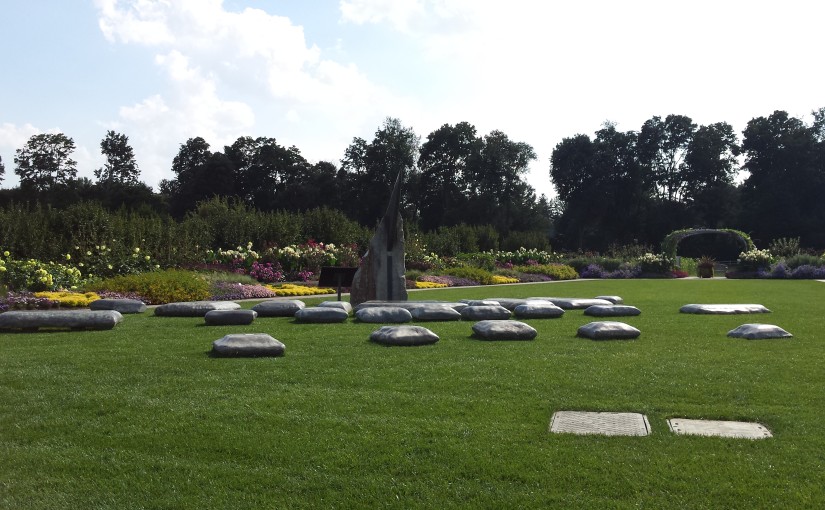- Introduction
- Besti Flokkurinn – The Best Video
- campaign video by Icelandic political party called Best Party
- Best Party
- sweeping victory in 2010 elections
- now holds majority in Parliament
- represents the establishment of a modern 21st century political party that is more focused on the current and future political situation than on upholding views and traditions from the past
- Besti Flokkurinn – The Best Video
- Rhetorical Situation
- video posted to YouTube
- two thirds of the video: members of the party singing about how they are the best
- final part: Jon Gnarr (leader of party) shouting a speech
- talks about what Best Party has to offer that makes it stand out
- ironic/comedic elements
- talks about what Best Party has to offer that makes it stand out
- Audience
- directed towards new/younger generation of voters
- cynicism – mocks outlandish promises that politicians tend to give while running in a last-chance attempt to garner favor with voters
- free towels at all public swimming pools
- build a Disneyland in Iceland
- polar bear for the Reykjavik Zoo
- economize: only need one Santa
- openly corrupt, as opposed to hiding government corruption
- video posted to social media platform
- singing is comedic, meant to show that the members of the party don’t take themselves seriously
- in acting like they don’t take themselves seriously, they present themselves favorably to younger voters that are fed up with the stuffy old political parties
- cynicism – mocks outlandish promises that politicians tend to give while running in a last-chance attempt to garner favor with voters
- secondary audience
- international viewers that see the video after it became well-known
- also young/new generation
- international viewers that see the video after it became well-known
- directed towards new/younger generation of voters
- Ethos
- mocks everything about traditional political parties
- demonstrates knowledge of current political parties and policies
- shows that they are self-aware as a political party
- cynicism appeals to younger generation as proof that the party is knowledgeable about current political issues
- mocks everything about traditional political parties
- Logos
- pseudo-logical argument: they are the best party because they are the Best Party
- promise that they will do away with deceitful government practices with sustainable transparency; if the government is corrupt, the people will know about it
- Pathos
- asks the people of Reykjavik to look inside their hearts and wonder if they want a brighter future with Best Party, or if they want Reykjavik destroyed
- talks about doing away with the old and bringing in the new
- curses out the old way
- promises ridiculous things that are obviously not serious; make viewers laugh and appreciate the self-ridicule of the political party
- promises are based on first-world problems that everyone complains about and can relate to, but that people don’t actual care about whether or not the situation gets better
- Visual Rhetoric
- background during song shows members of the party walking the streets and talking to people
- smiling, shaking hands, people on the streets enjoying themselves as party members hand out balloons
- Gnorr – while giving his speech, he is shown dramatically standing on a building, literally shouting from the rooftop
- Gnorr stands happily in the sunshine by a pretty lake with a dog
- Conclusion
- effective in a way that no one could have predicted
- perfect example of a group breaking from tradition in order to appeal to the next generation and stay relevant
- self-aware political party
- ∴ bringing about a new age of politics
Category: RCL Musings
RCL Post #4: Works of Art as Windows to Culture
Mark Tobey (American, 1890-1976) had a fascination with East Asian calligraphy, which informs his signature when creating abstractions. He first came across the calligraphy in Seattle and later studied the art in Japan and China. The thick brushstrokes characteristic of this written art are apparent in his work Westward Drift (1964). Calligraphy contains the energy of motion, registered as traces on paper or silk, with a focus on the rhythm and time in shifting space. Shaping the marks gives “spirit” to the characters, an ideology that Tobey (an adherent of the Baha’i World Faith) resonated with. He was fascinated by the idea of a global spirituality that was promoted by the Faith, as well as by what he called the “unity of man’s spirit.” In Westward Drift, the white almost-letters, strokes of color, and lack of a fixed focal point combine to create a sense of cosmic dynamism in which individual elements are subsumed, reflecting the main proponents of the practice of calligraphy and the Baha’i World Faith.

Norman Lewis (American, 1909-1979) has, until recent years, been unheard of in canonical accounts of Abstract Expressionism. Due to his African-American heritage, the modest scale of his paintings, and the way he would retain figural references within his lyrical abstractions, his name was kept off the grid, as people rejected these characteristics from the signatures of Abstract Expressionism. In his etching Carnaval (1974), the Caribbean celebration of “Carnaval” is not immediately apparent as the subject. However, closer inspection reveals elements of the festivities of Carnaval. Vestiges of parading celebrants appear amongst the jumble of abstract forms, and the repetition of specific characters in the parade alludes to the processional aspect of the festival. The gyrating humanoid figure at the top of the etching repeats in a counterclockwise motion, which parallels the same dancing movement performed in the festival itself. The Carnaval proceedings include observe tradition, religion, folklore, and culture, celebrating with a masquerade, calypso music, the crowning of a Calypso Monarch, a steel band competition, and many other activities.

RCL Post #3: Civic Artifact Speech Outline
1.brief introduction of the artifact
- The Garage Youth Center (West Grove and Kennett Square, PA)
- 2001: local business leader and youth pastor initiated renovation of closed garage into a space for middle and high school students
- first location in Kennett Square, then West Grove in 2011
- tutoring, mentoring, community service opportunities, computer access, youth groups, and enrichment activities
- almost 500 students between the two locations
2. explain how the event or opportunity in question can be seen as civic
- join the Hispanic and Native-English communities together in a common space to promote unity, help those in need, and gain a better understanding of each other’s cultures, thus helping the community to be closer as a whole
3. what ideologies and/or civic commonplaces are contained within or assumed by the artifact
- ***while not the original purpose, The Garage has overwhelmingly served as a way to unite the two groups in the area (Hispanic and Native-English speakers)*** – focus of speech
- promote idea of helping one another and helping for the sake of making the community better
- provide a safe environment outside of school
- enhance learning experience – give everyone equal opportunity to learn and understand the information taught
- promote understanding of different culture, but at the same time erase boundaries through events (painting, concerts, coffee house, tutoring sessions, after-school safe space)
- youths can express themselves and form positively influential relationships
- help members of the community in need of financial and/or assimilation assistance (auctions, food drives)
- help youths to meet social and educational obligations (e.g. college applications, job applications, computer skills)
4. explain how context and the rhetorical situation inform the piece’s message
- West Grove and Kennett Square both have very large Hispanic communities, with many first- and second-generation members
- many of the first-generation families cannot speak English or do not have a proficient grasp of the language, and the immigrant youths have to take extra courses in school or are limited to only taking certain courses
- the language barrier divides the towns, with stores providing for one or the other
- many people don’t get to experience the culture of the other group because of this language barrier (this is unfortunate, especially since the two towns have such rich examples of Hispanic culture that cannot be as easily found in other cities)
- thus, The Garage serves as a common ground for the two cultures to interact and learn about one another to create a culturally enriched whole, establishing a link with the immigrant population
5. explain how the artifact is framing the very idea of civic engagement
- allows youths to take the initiative to become more involved in the community and help themselves and others to become a part of a unified, culturally diverse whole
6. conclusion
- reiterate how awesome different cultures are and how important it is that everyone can be a part of the community without cultural differences holding them back
possible pictures (from The Garage website)
RCL Post #2: The Arboretum at Penn State
The Arboretum at Penn State serves as a popular destination for many groups, be it students relaxing or studying, children learning how to cultivate a garden, people getting married, or, as I most connect with, artists studying and capturing natural subject matter. The Arboretum houses a plethora of flora and fauna, and its beautiful landscapes provide a place for the artistic community to come together with the common goal of furthering knowledge and ability. Numerous opportunities for still life, landscape, and animal studies present themselves, from plants and ponds, to distant and wide views, to running water, fountains, and the many animals that venture through the grounds.
Due to constant traffic, the animals that live and/or gather food in the Arboretum are more relaxed around humans and are more likely to remain still and not flee at the first sign of a human approaching. Artists take advantage of this, finding a place to sketch where they do not have to worry about their subject suddenly taking off when it becomes aware of their presence. This allows artists to observe how animals move and interact with each other and how they act in their environment. With this knowledge, artists can better depict animals in their art in a way that is true to life.
The Arboretum serves as an amazing place for the artistic community to gather and learn. Art classes for beginners and experts alike can travel to the Arboretum for educational and practical experience, hobby artists can go for a relaxing session, and professional artists can obtain material for commissions or gallery shows. Things such as galleries (both those for professional work and for work done by art classes or members of the surrounding community) and commissions set the floor for sharing art with the greater public in the area outside of the smaller artistic center. By sharing their work, people can entice others to become interested in art—viewing and creating—and in the Arboretum. A community forms around the artists’ works: art is shared, public interest is peaked, and more people pursue art and visit the Arboretum.
RCL Post #1: My Learning Style
When I learn new information, I like to start with a broad topic and then break it down into smaller pieces of definitions, examples, perspectives of experts in the field, applications of the topic, and so on and so forth. For that reason, I feel that the picture of the archaeologist examining and tagging artifacts in a dig is most relevant to my learning style. In an archaeological dig, those involved begin by looking at the site as a whole, and then they mark the site off into smaller pieces, which reveal aspects of the site that would otherwise have gone unnoticed if they had just viewed the site at surface level (yes, that was an archaeology pun). Just like each artifact reveals something about the site, each subtopic in a new subject allows for a better understanding of the whole.







